Household chores and all things ‘domestic’ have become symbols for empowerment in the hands of textile artist Vanessa Marr. She has even elevated the meaning and intent behind the lowly yellow ‘duster’ to stand for female strength and a celebration of women’s contributions in the home.
Armed with a foundation of graphic design and a fascination with fairy tales, Vanessa is an activist of sorts with needle and thread. She seeks to especially raise attention and voice to women’s roles in the home across time and culture. And her collaborative stitch projects engage hundreds of women’s voices across the globe.
This article is packed with insider information related to Vanessa’s techniques. She shares her favourite stitches and materials, and she explains her creative process step by step.
Vanessa also schools us on the philosophies and fairy tales that underlie her work. Who knew the original storyline of ‘Little Red Riding Hood’ was different from that which most of us learned? And who knew there was a textile art activist movement of which we can all be a part?
We promise you’ll be both informed and inspired by Vanessa’s work. And you’ll never look at a duster in the same way again.
Vanessa lives in the South East of England where she is a Senior Lecturer and Course Leader at the University of Brighton. She originated the popular ‘Women & Domesticity – What’s Your Perspective?’ project and is a member of the Unfold Textile Group. Vanessa embraces an intuitive and practical approach, facilitating both storytelling and collaborative investigation.
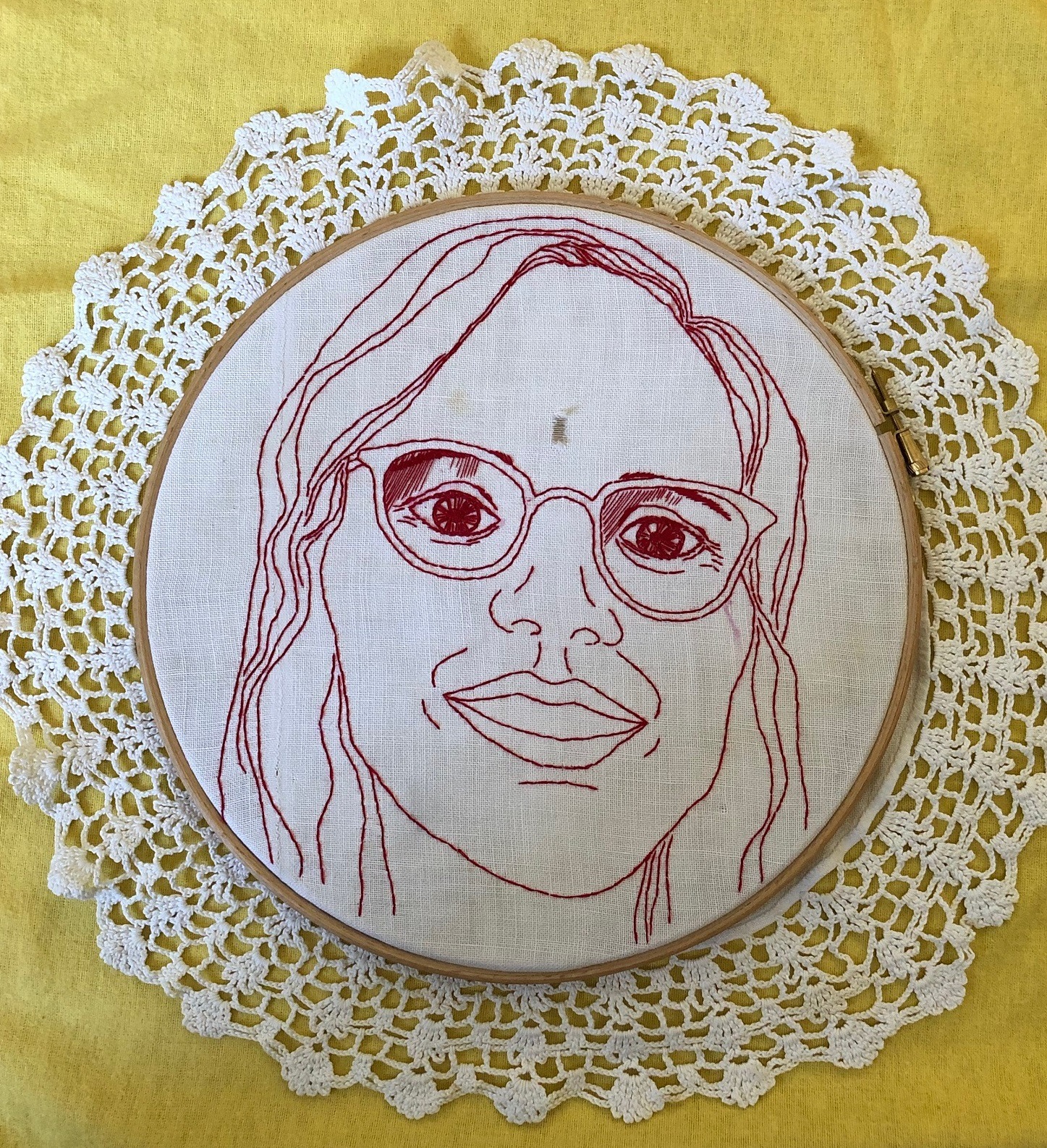
Domestic stitching
TextileArtist.org: What initially attracted you to textiles as a medium? How was your imagination captured?
Vanessa Marr: I love how textiles are portable. I always have a bag of stitching with me wherever I go, so my art-making happens around the rest of my life. This is a necessity because I have a family and a full-time job. So, I love that I can pick up my work at any time.
My imagination is captured by the experience of making textiles which, for my work, is mostly embroidery. But I enjoy knitting and crochet too.
The rhythm of working with a needle and thread takes me to a calm space where my mind can roam. I often have my best ideas in this state, and time takes on a new meaning. Whether it’s hours or minutes grabbed when I can, I always feel better for it.
And the ideas never stop rolling. The only hindrance is the time it takes to make them. That, in itself, is rewarding though, as each artwork holds memories of the spaces within which I created them. Each piece has a story that sits behind its ultimate intention.
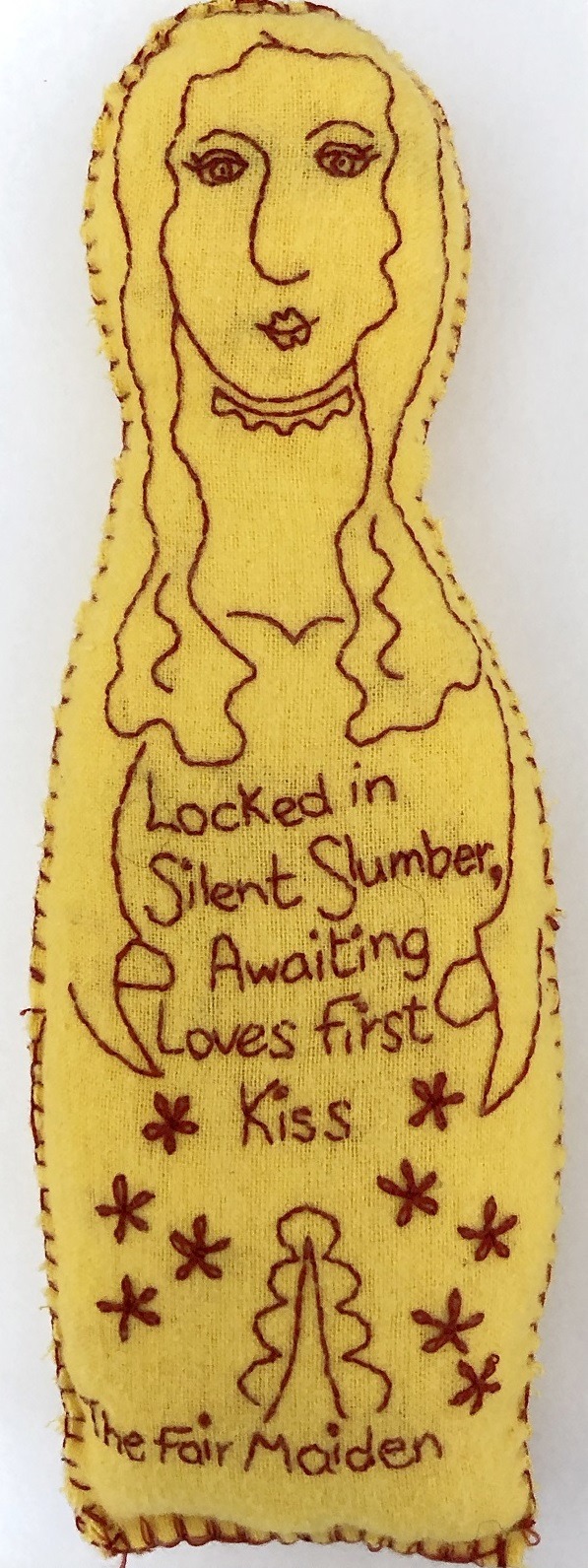
What or who were your early influences and how has your life/upbringing influenced your work?
I learnt to knit and sew when I was a small child. I was taught by my mother and grandmother, but it wasn’t until much later I realised it could be my art form. I had had a textile-based project ‘on the go’ for my entire life.
My grandmother taught me hand embroidery when I stayed with her each summer. And my parents bought me an old hand Singer sewing machine when I was 10, because I was scared to use my mum’s electric one. My interest in art and creativity was definitely encouraged, and I’ve always made for and with my own children.
Much of the artwork I make today is centered on the home and the domestic experience of being a woman. No doubt the early maternal influences and making that happened in my home space influenced that. I occasionally dream of a studio space, but in reality, I think my best making happens when life happens around it.
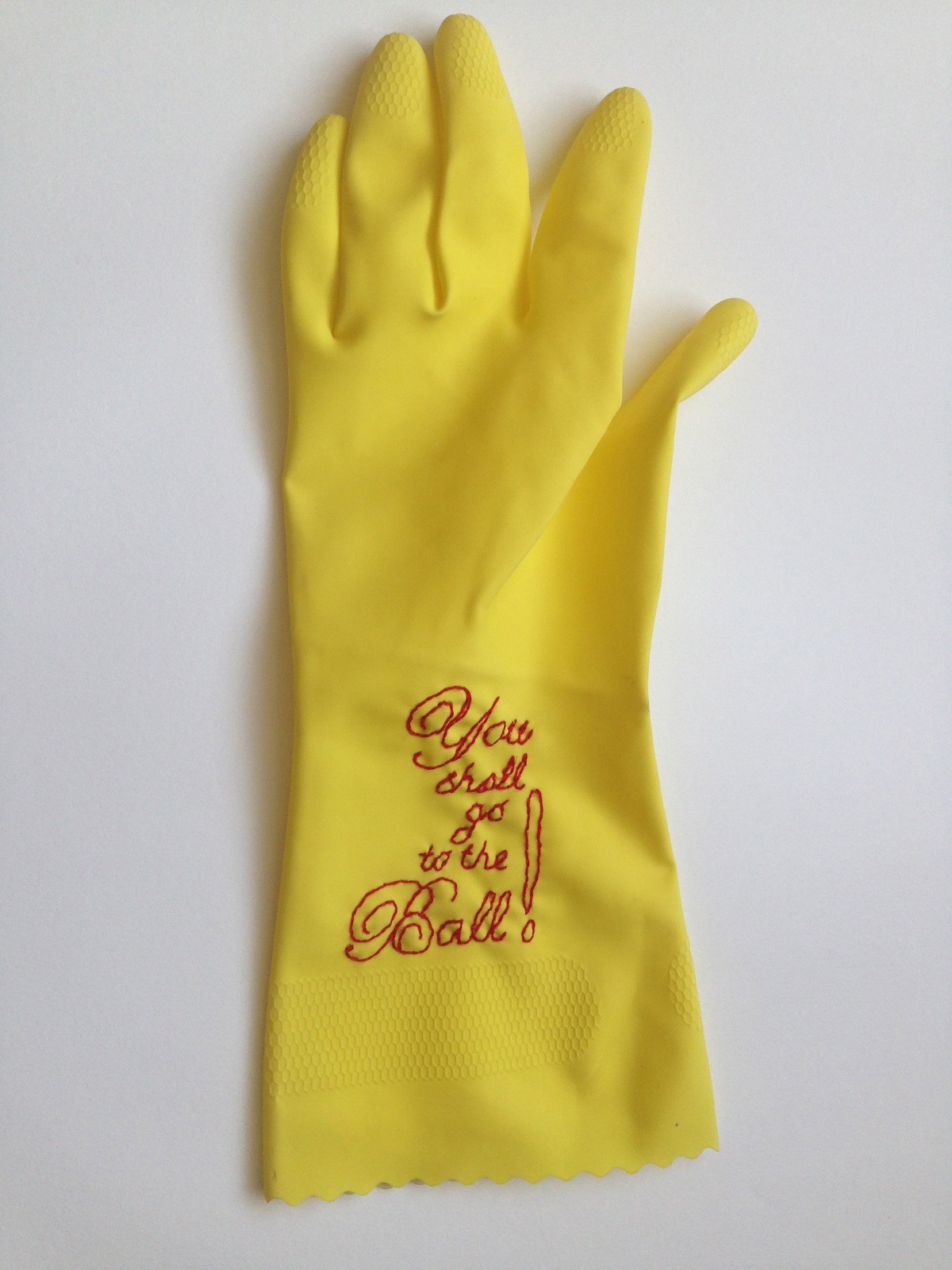
What was your route to becoming an artist?
My route to becoming an artist was through academic study. I studied graphic design at University, and for many years, textiles were a creative outlet that was personal and not something I considered to be art.
Study for an MA as a mature student in 2012 changed that, though, when I connected my research to embroidery as a creative practice. I discovered the domestic origins of fairy tales as stories that empowered women, often as they worked with cloth.
Women originally told each other fairy tales as they worked, often with cloth. Those narratives helped them make sense of the world, held advice, and often reflected society’s morals. Later they were adapted and borrowed by men (like Charles Perrault) who changed the tales to present women as vulnerable and in need of rescue and protection. A good example is ‘Little Red Riding Hood.’ The male version has a woodcutter rescuing the young girl, But the women’s early aural version of the story actually finds the young girl and her grandmother successfully tricking and defeating the wolf all by themselves!
The ‘Cinderella’ story particularly inspires me because of its roots in domestic context. The tale uses domesticity as both punishment and reward—cleaning up after the stepmother and her daughters then domestic ‘bliss’ through marriage to the prince. I think it mirrors some of the contradictions women still face today. I have written a chapter about this in a book soon to be published by Cambridge Scholars.
I really relate to the idea of working with cloth and storytelling and mirror this process in my own methodology. My portable method of hand stitching accompanies me to work and fits around motherhood, whilst the purpose of my art is often to empower myself and other women. In this way the combined legacy of cloth and story continues.
I also found a way to express and visualise that through embroidering images and subversive text onto bright yellow dusters. This expanded into an ongoing collaborative arts project inviting women to stitch their domestic experiences onto dusters and is now the focus of my PhD.
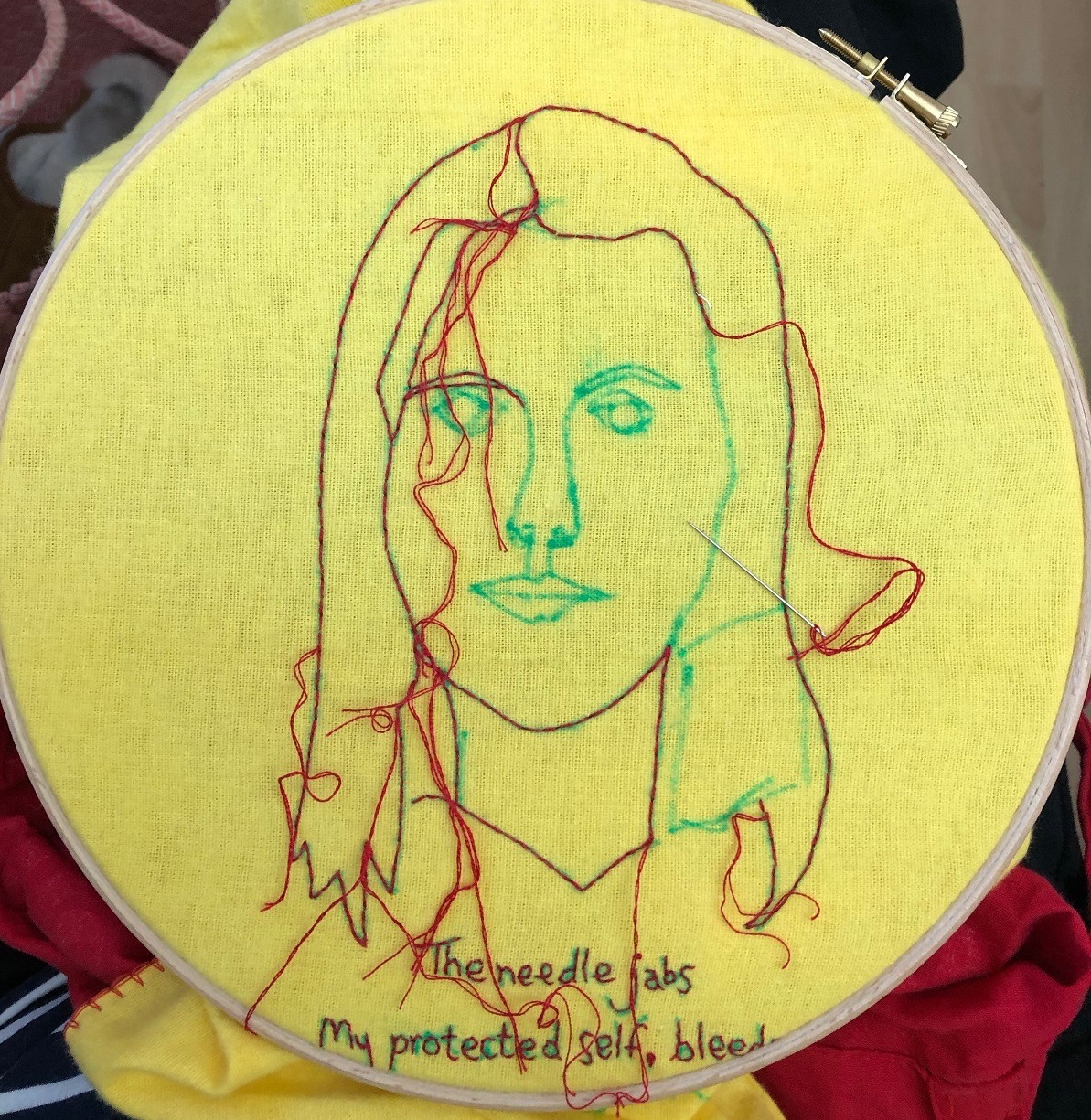
An activist approach to stitching
Tell us about your process from conception to creation
I rarely keep a sketchbook, although I often start them. I’m more of a back-of-an-envelope idea maker. I love starting projects but am much worse finishing them. So, I tend to create deadlines, even if they are artificial and just for myself.
I write notes and make quick sketches on anything to hand. And then once I have a full idea, I draw it. Sometimes sketching progresses onto the computer too.
My top tools are my needle, thread (red, if I’m working on dusters), and my embroidery hoop. But my lightbox also gets a lot of use. I usually trace my drawn image onto the cloth with an erasable fabric marker (the best invention ever!), and then I stitch over those lines.
I prefer embroidery silk, colour 321 by DMC. I go through loads of it. I also prefer 100% wool if I’m couching, although this seems a bit too delicate for crochet, so that usually requires a blend with acrylic.
Back stitch is by far my favourite, as it is so simple to draw with, and I can lose myself in the process. I also love a simple running stitch if I want to follow a more intuitive path or stitch more mindfully. I’ve recently started couching, which is nice to add a bit of texture to a piece. I can do other stitches, but for me it’s the process and the purpose of my artwork that drives me, so I prefer to focus on that rather than on lots of fiddly stitches.
For an erasable fabric marker, I prefer the blue type that dissolves in water. That way, if I leave a project to one side for a while (which often happens, as I always have several on the go), my marks don’t fade in the meantime. Also, if I can’t see through my fabric on the lightbox, sometimes I draw onto dissolvable cloth marked with the same pen, because I know I can remove it easily.
Lastly, the dust cloths I embroider on are bright yellow cotton and soft to the touch. They have a red stitched hem and a slightly nostalgic reference, as they are the type of cloth your Granny might have used to do the job properly!
My favourite duster is produced by the supermarket chain Sainsbury’s. It has a nice tight weave and stretches nicely into my embroidery hoop. I also like working with vintage dressing cloths and have even stitched a rubber glove!
I like to choose textiles that hold a message and purpose of their own that can bring something to the artwork that supports the message. For example, I chose the duster because it is cheap, not considered special and is unadorned (unlike tea towels or aprons, which are often decorated). It reflects the low status and perceived value of domestic tasks.
However, the dust cloth is actually soft and bright, and when embellished with embroidery and exhibited as I do with my ‘Women & Domesticity – What’s your Perspective?’ Project, it presents a powerful proclamation of voices that call for acknowledgement. The duster is perfect, as it is instantly recognisable in the U.K. as a domestic cleaning cloth, so it visually ‘speaks’ domesticity, which makes it a powerful visual tool for me as an artist.
Sometimes I edit as I go, but this technique gives me a framework from which I can work. (Clearly, the graphic designer in me still lingers.)
Sometimes I stitch intuitively, but strangely, doing so needs more head space. So, it depends upon the context within which I’m working. In any case, I always have more than one piece on the go.
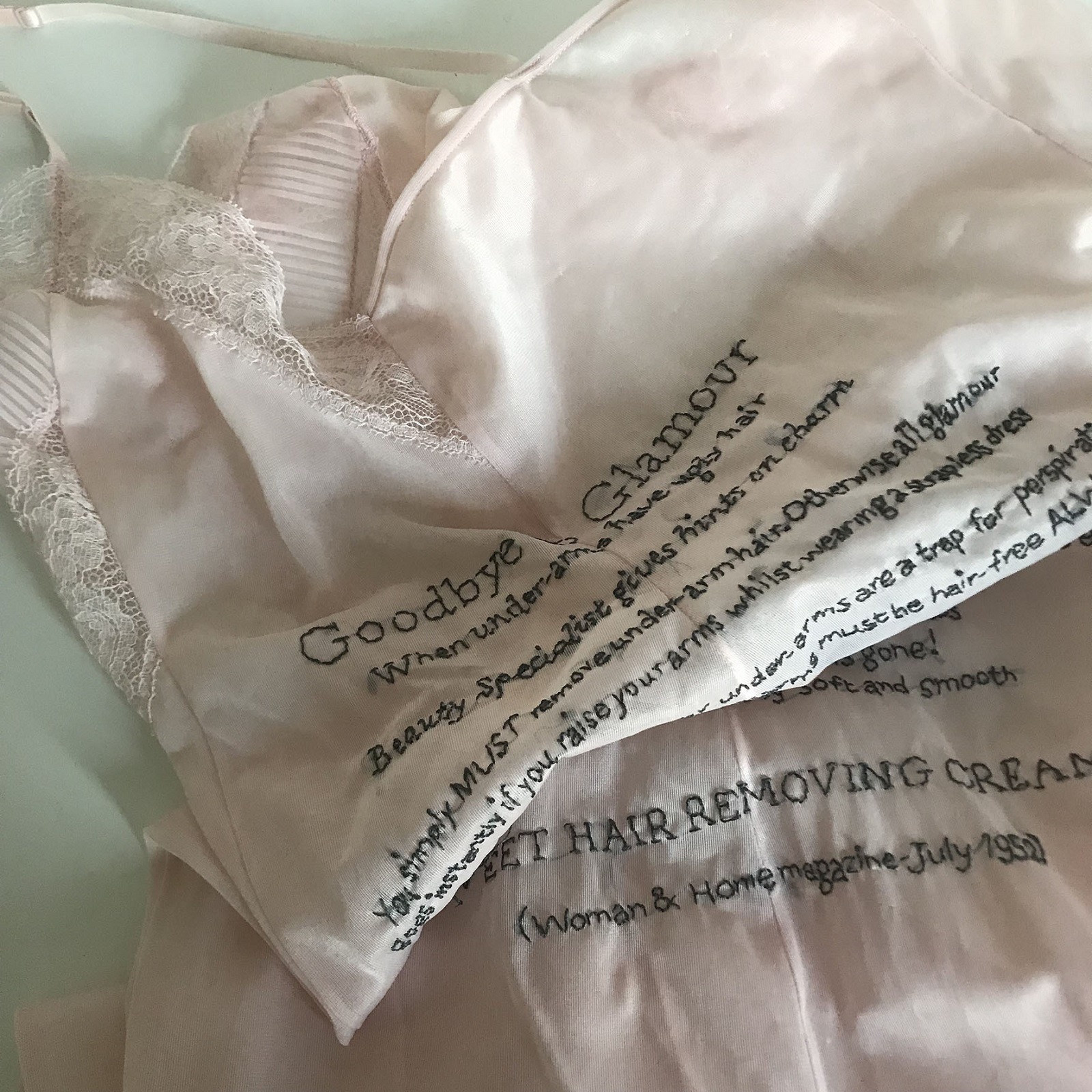
Tell us a bit about your chosen techniques and how you use them
I use embroidery as a means of visually communicating by stitching messages, images and statements. I am inspired by its legacy as ‘women’s work’ and which Rozsika Parker writes about in The Subversive Stitch: Embroidery and the Making of the Feminine .
I selected dusters as a metaphor for domesticity and the red thread as a means of visualising femininity. I initially chose red thread to match the edges of the dusters I stitched into, but I quickly found it had a powerful connection to femininity too. It is historically used to represent fertility and female sexuality, so by choosing that colour in particular, I can reference some of the power of womanhood in my work without the need to explicitly say so. It is suggestive through connotation which combines well with the textile object choices I made to give more power to my messages.
This also references practices like ‘Craftivism,’ and through my collaborative ‘Women & Domesticity’ Project, it has become a means of collaboration with other women as a source of empowerment. ‘Craftivism’ is a word coined by Betsy Greer that sums up the use of craft (usually embroidery, knitting and crochet) to make powerful statements that entice change. Sarah Corbett also writes about this practice as a quiet means of protest—literally craft and activism combined.
My ‘Women & Domesticity’ duster project that I started in 2014 explores the relationship between women and domesticity and invites women to embroider their perspectives and experiences onto a traditional yellow duster. The growing collection of over 100 hand-embroidered dusters proclaims a multitude of opinions that include poetic quotes, resentful statements, graphic representations, and sculptural manipulations of the cloth.
When displayed, the Collection of so many different voices sharing a common theme promotes a powerful empathy and visual persistence by releasing our stories through stitch. This is both empowering for me as the organizer, as well as the participants, through shared experience. And it also empowers viewers of the Collection, who often report ‘I relate to that.’
The first step in making change is to acknowledge it, then to encourage others to acknowledge it too. Craftivism is a means for anyone to feel empowered to make a difference by declaring the need for change.
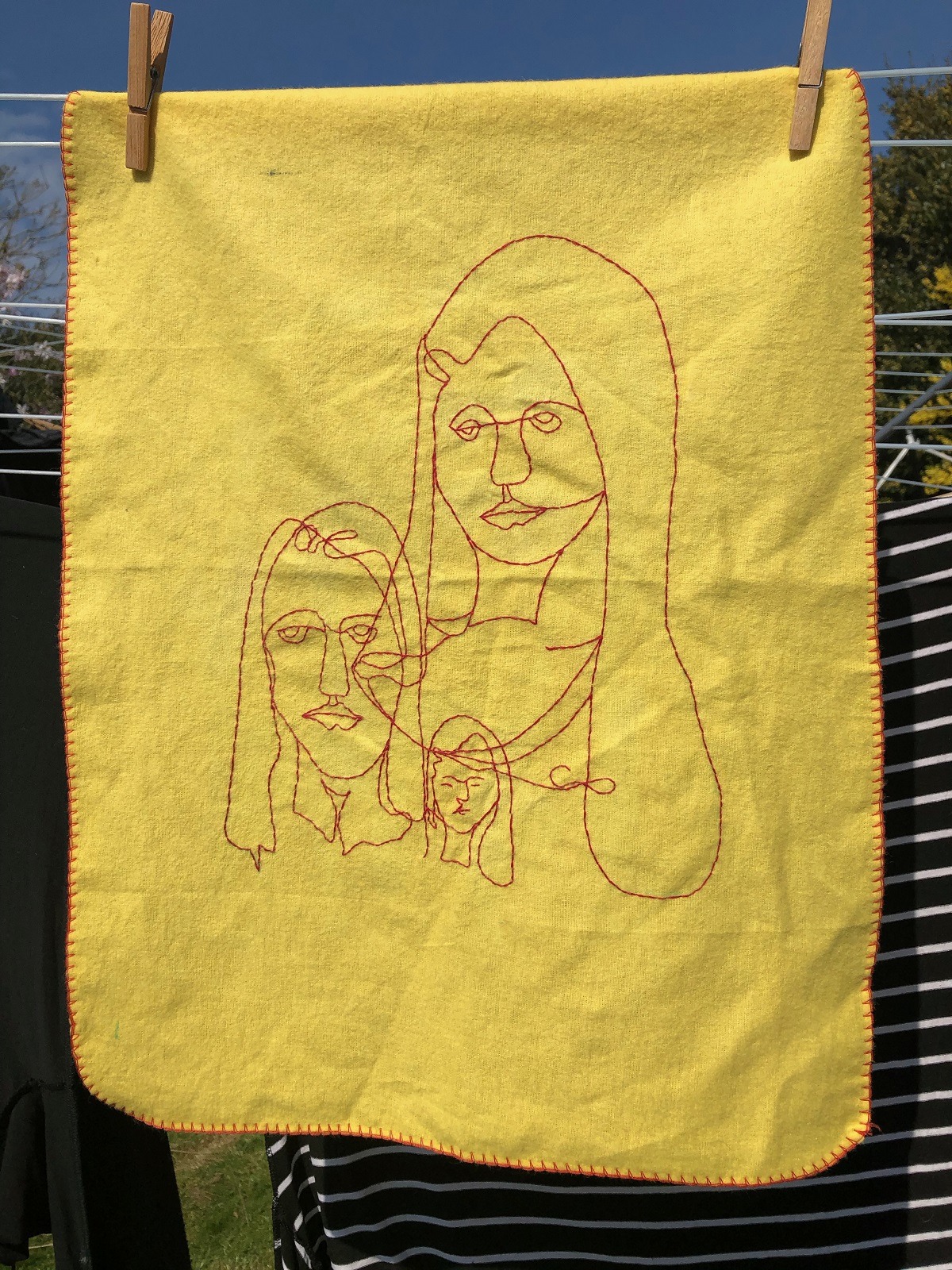
What currently inspires you?
I’m inspired by my domestic life—the living that surrounds me. I adore the work of Louise Bourgeois, particularly her fabric sculptures. And I also appreciate the way Grayson Perry makes art seem approachable and ordinary.
Reading is also a great source of inspiration, both novels and academic writing.
Fairy tales continue to inspire me, because I love the way you can play with their ubiquitous themes.
I also love Carol-Ann Duffy, particularly her Feminine Gospels poetry collection.
I’m inspired, as well, by any textile work that holds a story, whether it’s an old dishcloth or a treasured quilt.
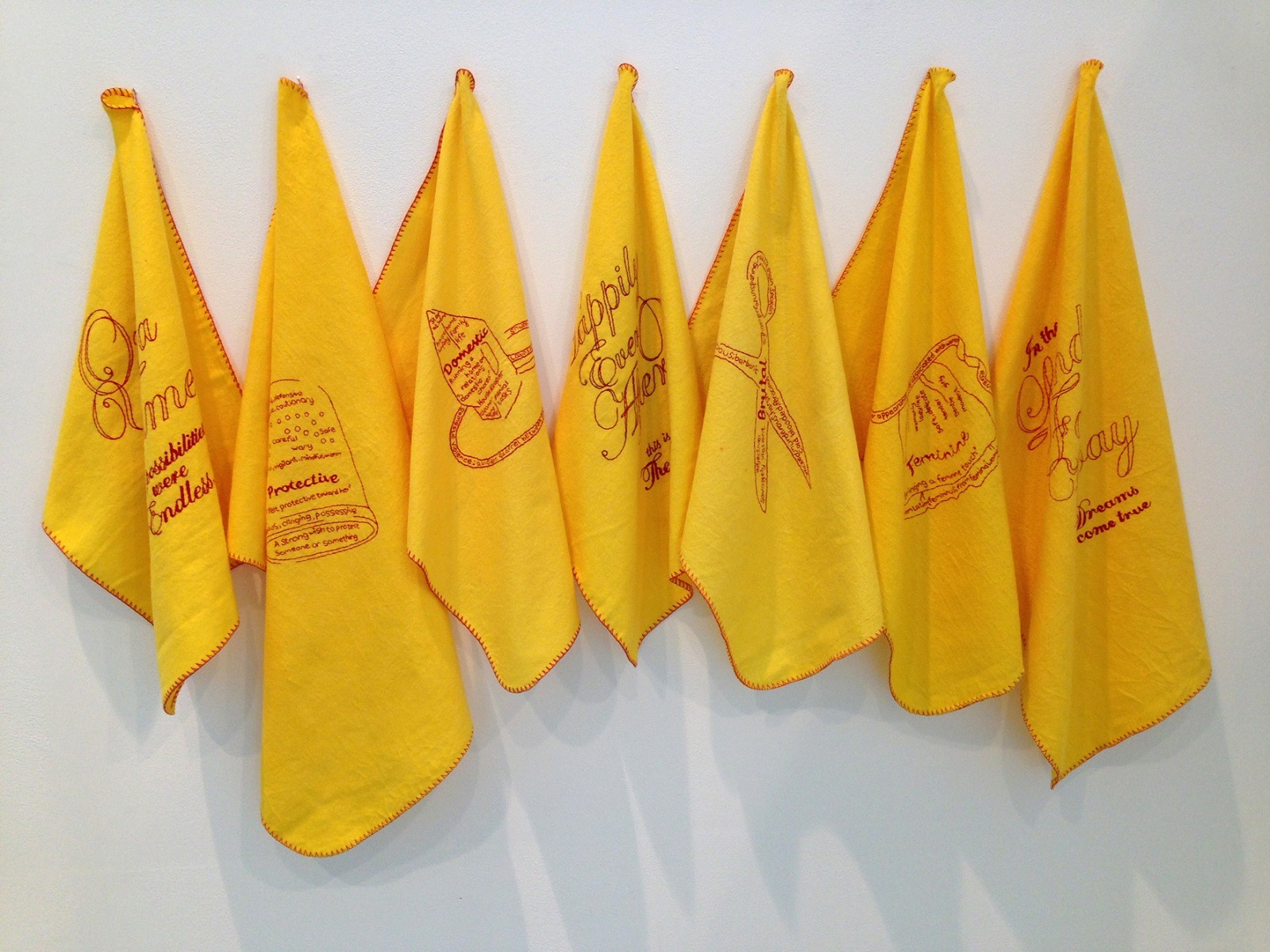
It’s all about the story
Tell us about a piece of your work that holds particularly fond memories and why?
I’m particularly fond of the first piece I made with the dusters called ‘Promises and Expectations.’ It was the realisation of the MA study and the piece I return to as the starting point from which I defined myself as an artist.
It includes fairy tale statements that I subverted with subtitles. For example, ‘Once Upon a Time’ had the subtitle ‘Her Possibilities Were Endless.’ It also includes objects related to cloth that are accompanied with definitions of femininity (an apron) or protectiveness (a thimble).
That work marks a pivotal point in my creative life that inspired the ‘Women & Domesticity’ duster project, which has led to many exciting opportunities.
I also remember the story of stitching on it: on the train to and from work and study, and on holiday with my mum following my dad’s death from cancer. It holds its own messages, but for me, it’s also a personal story.
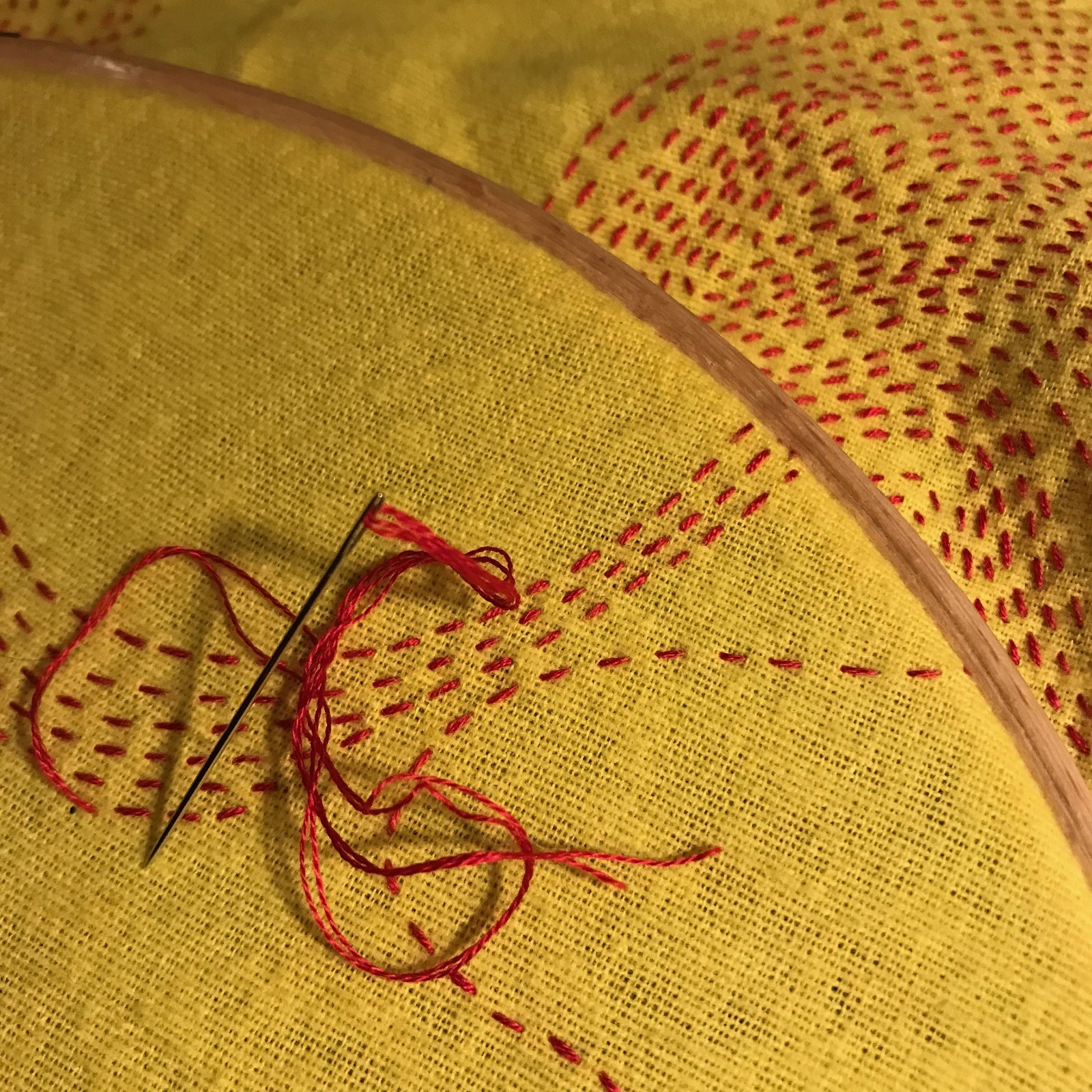
How has your work developed since you began and how do you see it evolving in the future?
Initially my work was very statement led with a clear plan and often an image that supported it.
But as it’s evolved, I have learnt to work more intuitively. I’ve also realised my personal need of an object with which to connect. A lot of time those objects are dusters. But there have also been other items, including a collection of vintage nighties and dressing tablecloths that I subverted to highlight the ridiculous messages that advertising presents to women.
Throughout my work there has always been a purpose to communicate something—to tell a story or show a perspective.
As noted earlier, my stitching on dusters has become a catalyst for other women’s voices. So, my work continues to evolve in that direction: inspiring a response through its message but also through the simple act of stitching.
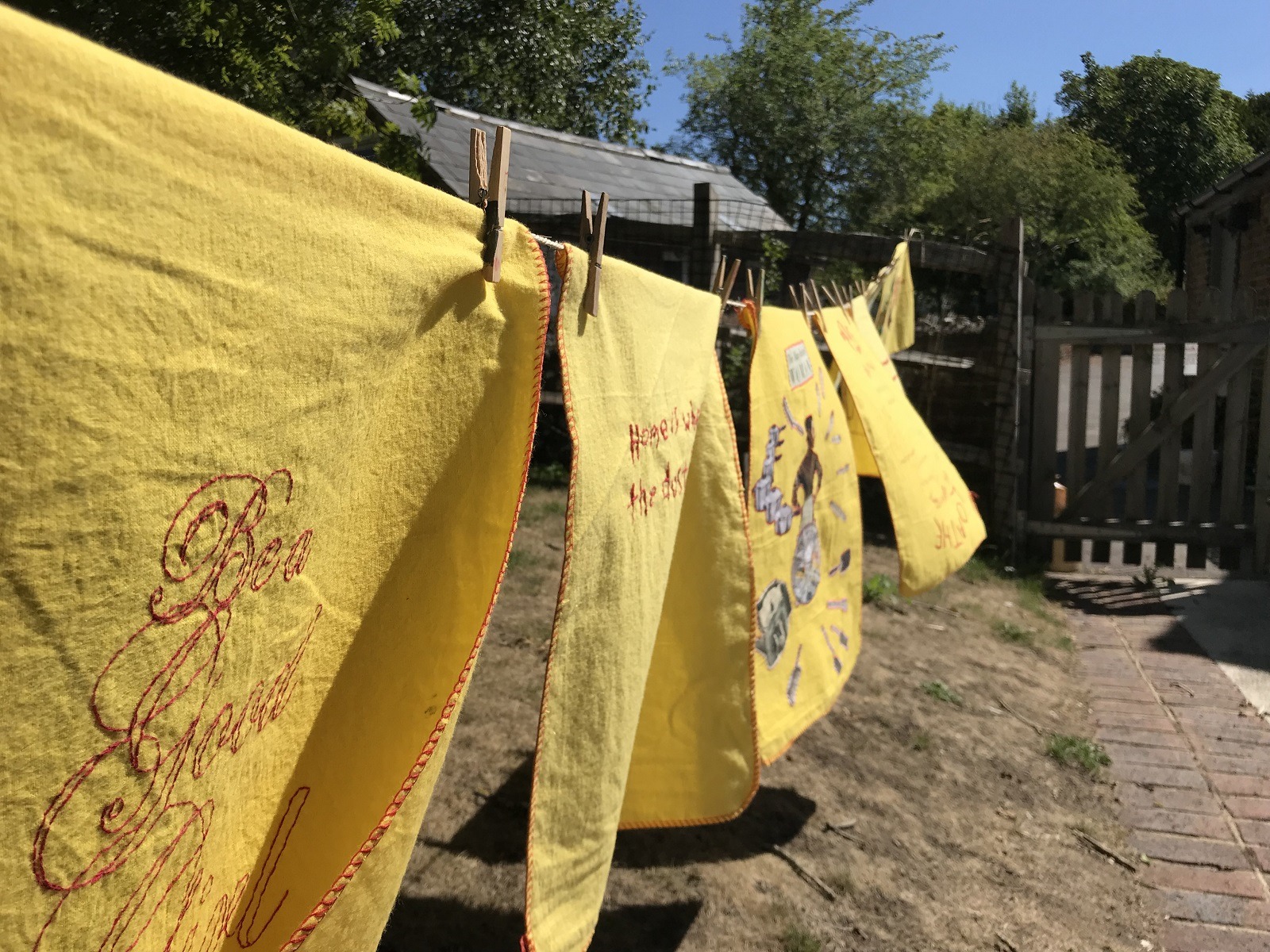
What advice would you give to an aspiring textile artist?
Be original and believe in yourself.
Don’t worry if you don’t have specialist textile training or use a hundred different stitches. I don’t have the training, and I mostly use back stitch.
You own your imagination. That is something no one can ever take away from you, so treasure it, but also share it. In my experience, it will come back and reward you many times over.
For more information visit domesticdusters.wordpress.com
If you were to participate in Vanessa’s duster project, what message might you stitch onto your yellow duster? Let us know below.
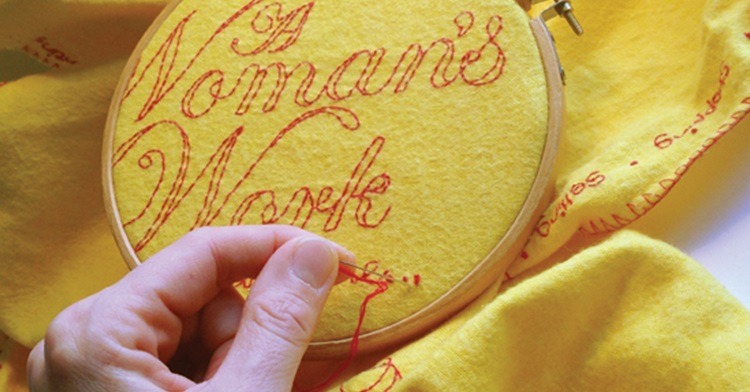
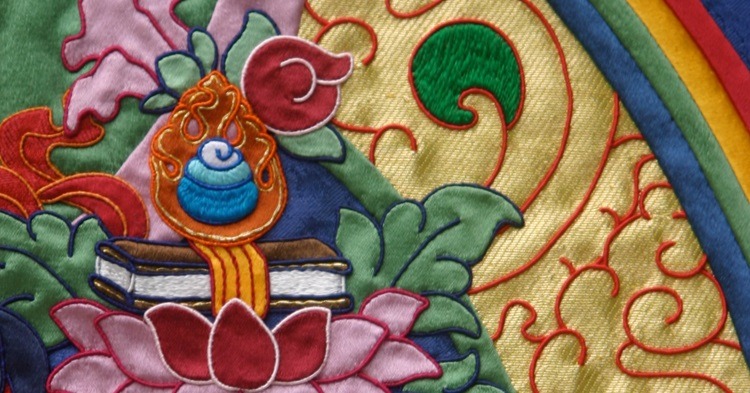
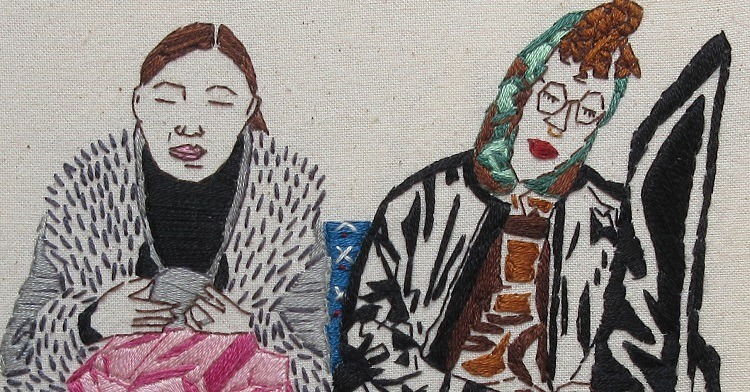
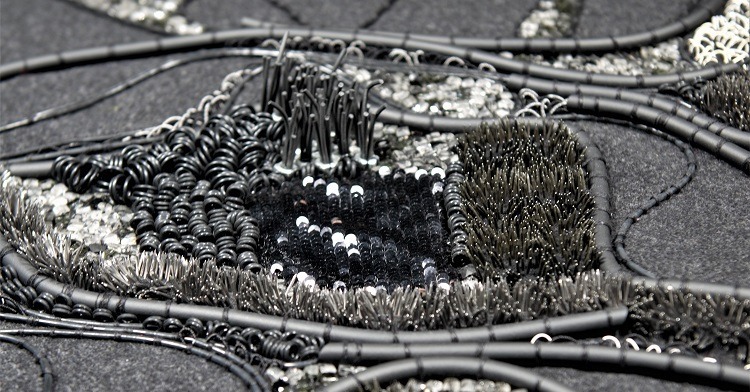
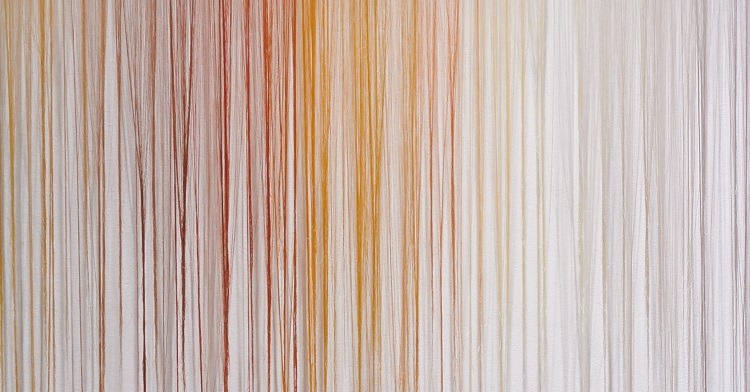
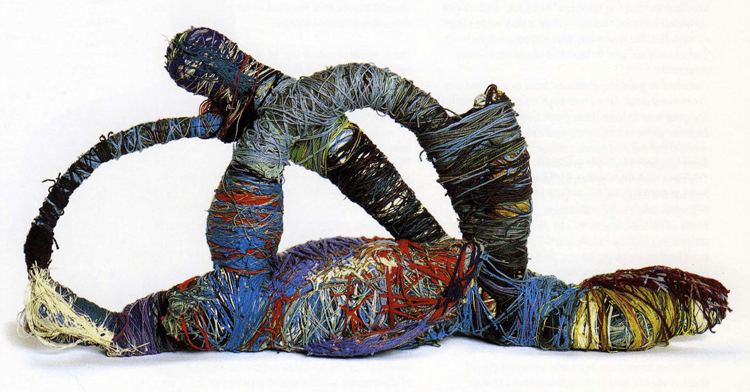
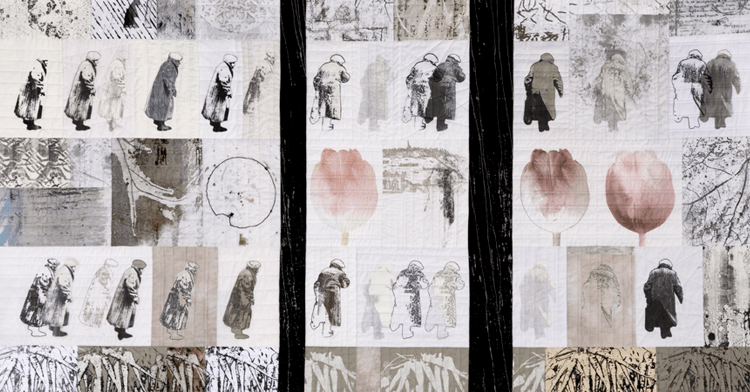
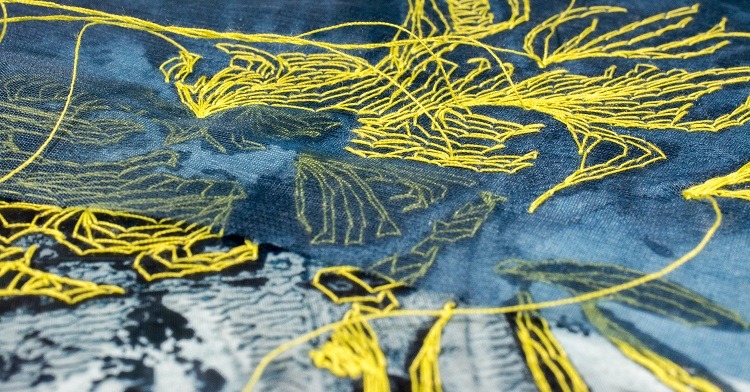
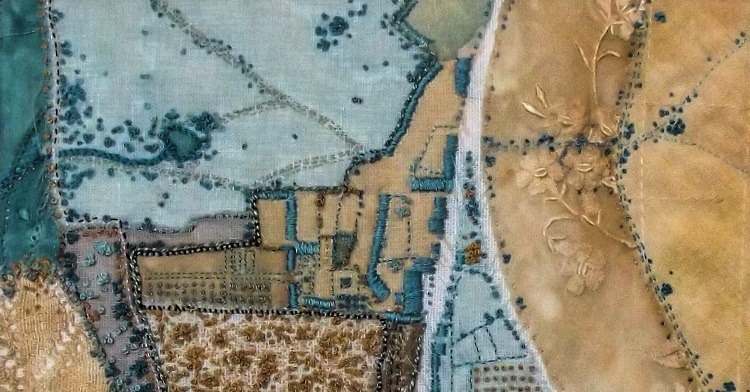
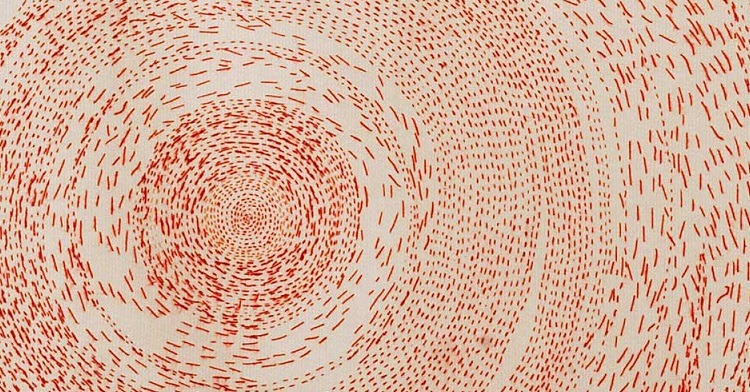
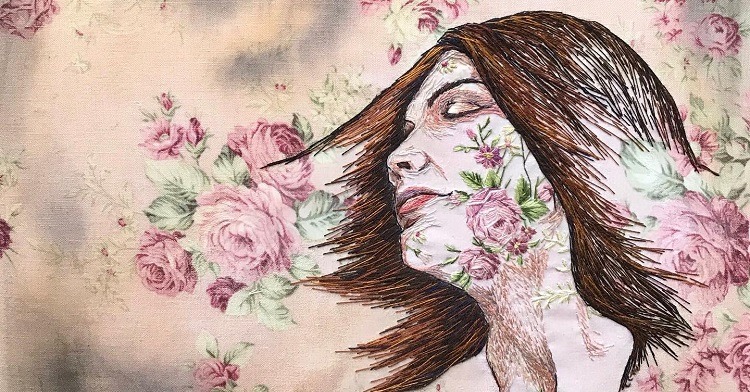
12 comments
Jayne Butler
Reading your story reminds me that I grew up with charcoal and needle and thread in the one hand together, I now understand that I abandoned rules except for my maternal grandmothers’ rule to have anything I make as ‘perfectly beautiful’ as possible, never to shirk on the quality of stitch but now I find that restrictive and your work shows me that the underlying thought is the most important message. I struggle to believe in my self and my art so thank you for reminding us how important and valued we are, that there is no fool like the one that runs a finger across the dust and sees not the art.
Gemma Pratt
I love your work, it really speaks ro me about the ways in which women are defined by the roles they have. I would stitch the words A Domeatic Goddess but stitch a cross through domestic. A womans worth is not defined by how clean her home is.
Margaret Heywood
Dust if you must but you just might bust
Vanessa Marr
Absolutely! If you’d like to join the project I’d love to include you, you can message me through my blog or on Instagram @vanemarr
Vanessa x
Margaret Marks
If I created a stitched duster I would write:
“I prefer to stitch than to dust.”
Vanessa Marr
Me too! If you’d like to stitch a duster and join the project you can message me through my blog or on Instagram @vanemarr
Vanessa x
Sharon
“Stop to consider the impact of the choices that you make.” would be on any duster I would make.
Vanessa Marr
Love it! If you’d like to stitch a duster I’d love you to join the project. You can message me through my blog or on Instagram @vanemarr
Vanessa x
Mary Anne
I loved this article – and the inspiration it gave. I would never have thought of creating onto something as ‘normal’ as dusters but it’s something that speaks to our roles as women, at least in the traditional sense. If I were to create a duster, my words would be a quote from Nikki Banas…”If you only carry one thing throughout your entire life, let it be hope”.
Vanessa Marr
Thank you, what a wonderful message. Would love you to join the project and stitch a duster, it’s still ongoing. You can message me through my blog or on Instagram @vanemarr
Vanessa x
Sue Szczotka
I immediately thought of what I would put on my duster when I read your article – “Don’t give me a blender for my birthday; I want a power saw!”
Too bad we don’t have those dusters in upstate New York…
Vanessa Marr
Thank you so much for your lovely comment. If you message me on Instagram @vanemarr I’d be happy to post you a duster to stitch. Would love to include you in the project. Vanessa x